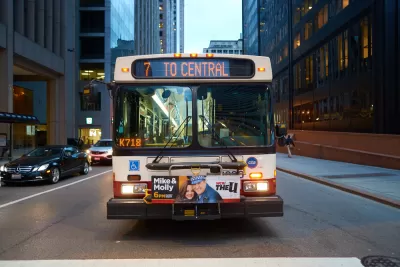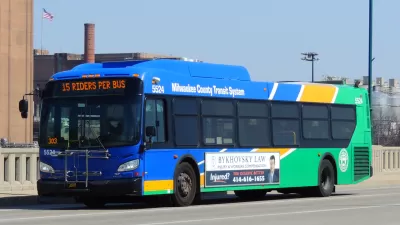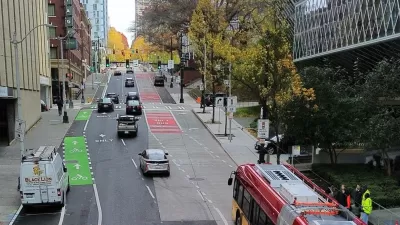City officials say funding for dedicated bus lanes could take years, but other improvements could speed up bus service.

Chicago City Council members say the city may not see true bus rapid transit (BRT) anytime soon, but “Instead, officials with the CTA and the Chicago Department of Transportation told the Committee on Pedestrian and Public Safety they are also exploring smaller efforts to improve bus travel, such as traffic signals that wait for buses to pass and ways for buses to skip ahead of traffic.”
In an article for the Chicago Sun-Times, David Struett writes, “This is a “dual-track” mindset that the CTA has recently taken up to try to improve bus travel as the agency waits for longer-term federal funding for bigger projects, said Molly Poppe, CTA’s chief of planning and innovation.”
Dedicated bus lanes in some parts of the city sped up bus arrival times by 12 to 21 percent. The city is studying the potential for more bus improvements via its Better Streets for Buses project.
“One improvement is traffic signal priority, a technology that delays a green light from turning red if it senses a CTA bus nearby is running late. The city has installed this at 130 intersections, and plans to install 49 more in 2025, said Vig Krishnamurthy, managing deputy commissioner at CDOT.”
FULL STORY: Bus rapid transit a possibility in Chicago but still a long way off, transit officials say

Trump Administration Could Effectively End Housing Voucher Program
Federal officials are eyeing major cuts to the Section 8 program that helps millions of low-income households pay rent.

Planetizen Federal Action Tracker
A weekly monitor of how Trump’s orders and actions are impacting planners and planning in America.

Ken Jennings Launches Transit Web Series
The Jeopardy champ wants you to ride public transit.

Rebuilding Smarter: How LA County Is Guiding Fire-Ravaged Communities Toward Resilience
Los Angeles County is leading a coordinated effort to help fire-impacted communities rebuild with resilience by providing recovery resources, promoting fire-wise design, and aligning reconstruction with broader sustainability and climate goals.

When Borders Blur: Regional Collaboration in Action
As regional challenges outgrow city boundaries, “When Borders Blur” explores how cross-jurisdictional collaboration can drive smarter, more resilient urban planning, sharing real-world lessons from thriving partnerships across North America.

Philadelphia Is Expanding its Network of Roundabouts
Roundabouts are widely shown to decrease traffic speed, reduce congestion, and improve efficiency.
Urban Design for Planners 1: Software Tools
This six-course series explores essential urban design concepts using open source software and equips planners with the tools they need to participate fully in the urban design process.
Planning for Universal Design
Learn the tools for implementing Universal Design in planning regulations.
Ada County Highway District
Clanton & Associates, Inc.
Jessamine County Fiscal Court
Institute for Housing and Urban Development Studies (IHS)
City of Grandview
Harvard GSD Executive Education
Toledo-Lucas County Plan Commissions
Salt Lake City
NYU Wagner Graduate School of Public Service





























